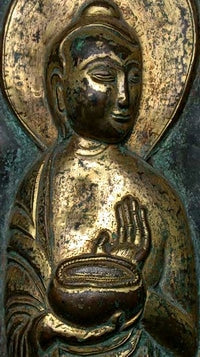Types of Singing Bowls
While crystal singing bowls are growing in popularity, Bodhisattva Trading Company specializes in new (contemporary) and antique metal singing bowls made of a bronze alloy. Our bowls are sourced from Nepal with the antique bowls often coming from throughout Asia.
We have included a glossary of the vernacular we have developed over the years of our business to differentiate between the different construction types and styles of singing bowls. The bowls’ makers were very creative, and they spanned throughout the Himalayas over the course of centuries. There are many different nuances in shape and intricacies in design to notice! As we have not yet found the Tibetan, Nepali, or Hindi terms which describe them all, we have invented names for them in order to communicate with our customers, and each other, about them.
Use these terms with other bowl dealers with caution. If you know of any other information on any of these types, their indigenous names or provenance, please contact us. We’d love to hear from you.
Thadobati
Nepali term for a medium sized, (6″ to 8+”) bowl in which the walls are proportionately higher to the diameter than the Manipuri, or Low-wall style.
Jambati / High-Wall

Nepali term for a larger diameter, (8″ – 14+”) bowl in which the walls are proportionately higher to the diameter than the Manipuri, or Low-wall style. These are the largest and deepest sounding of all the Tibetan singing bowls. Fundamental tones can range from the second to the third octave of a piano. The rim tones can spread into the fifth octave. They are highly prized for their deep basso profundo Om tones.
Manipuri
Said to come from the Manipur region (in the eastern Himalayas near Nagaland), but this shape is also typically Tibetan as well. Their walls are lower in ratio to the diameter, with a gradually sloping base. Typically, they range from approximately 4 up to 10 inches, and their tones, likewise, range from the second to fifth octaves.
Low-Wall

A thinner constructed Low-wall Manipuri bowl. A Low-wall-thick-lip is a Manipuri bowl with a thicker construction and a triangulated lip. Sometimes these are decorated with sacred geometric patterns (see Void description below).
Buddha

A medium sized (6″ – 8″) Thadobati variety singing bowl. The base, while still round, is not as sloped as a High-wall. We named this style after the Buddha because one of the earliest depictions of the Buddha, a 1st century BCE stone bas-relief from the Ghandaran period, features the Buddha holding a bowl of this shape. This theme, called “The Offering of the Four Bowls”, was also found in a later, 2nd – 3rd century CE bas-relief (see photo at right) as well. The provenance of this shape generally tends to come from India.
Karma

A medium sized (6″ – 8″) Thadobati bowl. Similar to the Buddha type bowl but with side walls that are less rounded and with a bottom which is more flat. Also many have vertical hash marks on the upper exterior walls.
Tara
Another “cousin” of the Buddha type (Thadobati) bowl, it’s body is deeper and rounder giving it a more feminine feel– hence the name. Medium sized (6″ – 8″).
Special
Extra thick construction, Buddha shape, but generally with a a rounder wall. Usually features heavy sacred geometric parallel lines incised or cast into the exterior walls, and orbiting out from a small circle in the center of the basin. The lip is distinctly grooved.
Void

An enigmatic, premium quality bowl with geometric design patterns and construction which were made with remarkable consistency from the 15th through the 19th Centuries. They feature a ribbon of dots surrounded by small circles on the exterior wall under the lip. This was an ancient, sacred geometric symbol. It was first seen in astrology as the Sun sign. It represented “the one becoming aware of his or her source”*. In a Himalayan, or Tibetan Buddhist context, we believe this symbol represented recognition of the Void – known in Buddhism as the doctrine of dependent origination. Each individual is inseparable from the All. The dot is the contracted circle; the circle is the expanded dot: as above, so below. A pattern of concentric circles frame the ribbon, and also appear half way down the exterior wall. Another set of concentric circles orbit out from a small circle in the center of the basin. The patterns of concentric circles were a represented the infinite expansion of vibration into the Universe**. These markings actually depicted the function of the singing bowls: showing wave patterns emanating outward, they remind seekers throughout time that the vibration of our thoughts, words and deeds resonate infinitely out into the Universe.

All Voids have a “pie-lip” construction, a primitive technique we first observed in 10th Century bowl construction. In the forging process, the metal was folded over and then the excess rim trimmed off, rather than simply being sheared off at the top
Void-Yoni


We believe these special bowls may have been intended as the female counterparts to the Voids. They are identical in construction, but also feature three dot/circle patterns forming a downward-facing triangle, placed in four locations around the bowl’s exterior wall. In the Tantric traditions which were practiced in the Himalayas during this time, downward facing triangles represented the “Yoni”, or female principle. The repetition of this pattern in sets of four around the bowl may refer to the four vectors: North, East, South, West. These may also refer to the four directions of Tibetan Buddhist ritual practices. Rarely, there will only be three sets: the fourth triangle must be invisibly traced between the three physical locations to form the fourth triangle.
Bodhi

Dharma

Typically light construction, with slightly concave aperture and a generous belly. Multiple parallel line patterns are lathed around the exterior wall. Often, a dot-line inscriptions will appear approximately half an inch below the rim on the exterior wall. These bowls may have been partially cast as well as forged. Usually, a set of concentric circles orbit out from a small circle in the center of the basin. The lip is usually grooved.
Cup-bowl

A smaller diameter, cup-shaped Tadobati variety Tibetan singing bowl. Highly portable, good for use on smaller alters, and also for healing professionals as they can easily be placed on the brow to activate the 3rd eye chakra and/ or pineal gland when the bowl has an A tone. Also, due to the smaller sizes they produce higher octaves which fill in this part of the scale when being used in musical compositions. Diameters range from just under 4 inches up to 6 inches.
Lotus

A more globular type of singing bowl with usually thin and high walls. Like the Lingam type bowls, they also have an area in the bottom interior basin which has been forged to produce an upward pointing protrusion. Sizes range from below 6″ to around 8+”. Due to the relatively thin walls many of this type of bowl produce deep struck tones.
Pedestal

A type of relatively rare singing bowl which has a raised ring attached (usually soldered) to the outside bottom of the bowl. This ring is useful as a grip when the bowl is used in sound healing applications as the bowl can be waived around various parts the patients body more easily. Stylistically, a comparison can be made to the porcelain stem cups used by Tibetan nobility, although these have a longer stem.
Mani


This means “jewel” in Tibetan, although we believe the style hails originally from India. They are the only example that we know of which is a conically shaped, self-amplifying singing bowl. They tend to produce an almost pure sine wave, and their rim tone and fundamental tone are the same. Sometimes, higher harmonics can be heard in the struck tones, but they tend to be octaves rather than tritones.
Lingam bowl


Perhaps the rarest of all the Tibetan/Himalayan type singing bowls, this type has a conical protrusion coming out of the center of the bowl’s interior basin. The term “Lingam” comes from the Sanskrit terms for “phallus”. The Lingam has been worshipped by Shaivite Hindus as the formless aspect of God for millennia. In the Buddhist, Bon, Hindu, and Jain traditions this protrusion and accompanying multiple ring lines is also symbolic of Mt. Kailash and the practice of circumambulating this most sacred mountain in western Tibet.

A Note on Master-Quality
The Tibetan Singing Bowls offered by Bodhisattva Trading Company are both new contemporary styles and antiques from the Himalayas of Nepal and India, many between 100 and 400 years old. Each special bowl has been personally selected by either Shakti, who has been collecting, researching, and recording Tibetan Singing Bowls for over 25 years, or Lewis, who is a lifelong musician and current owner of the company.
